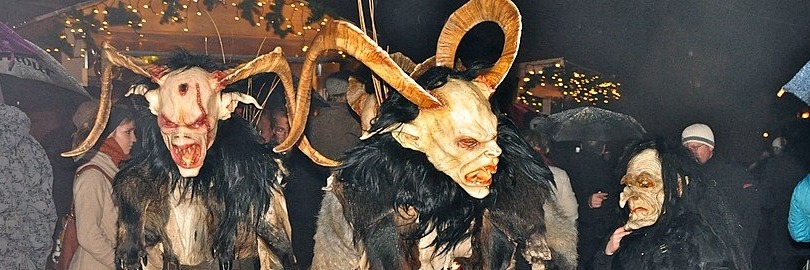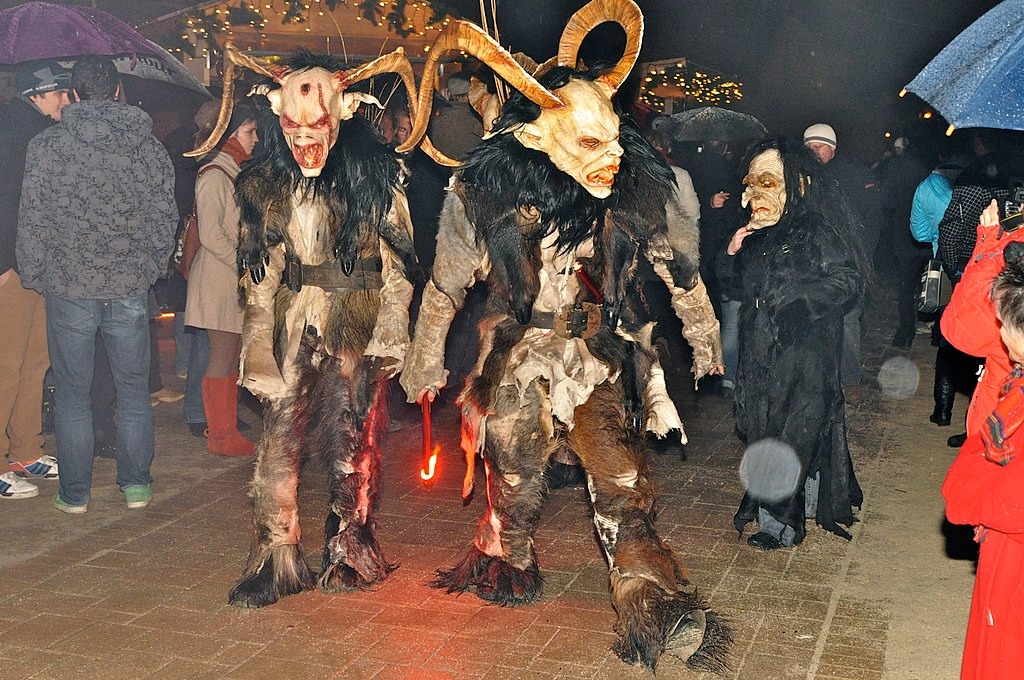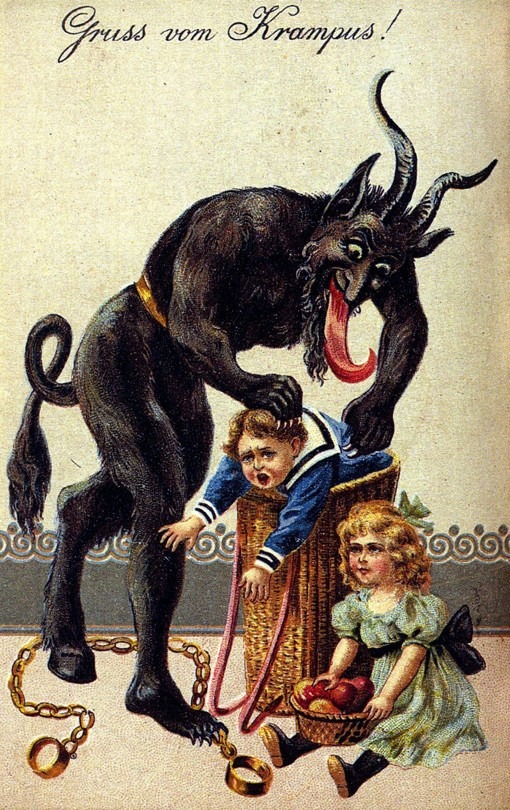Christmas is usually seen as a time of joy and celebration, and in many traditions Santa Claus rewards all children who have been good throughout the year with gifts, while those who haven’t been nice can receive a lump of coal instead. However, in Alpine folklore, bad children get an even harsher punishment: a visit from the Krampus.
The Krampus is a half-man, half-goat demon, and is usually represented as brown or black with a hairy body, along with cloven hoofs and the horns of a goat. The demon is also often shown with fangs and a pointy tongue sticking out. The Krampus carries chains, which symbolize its link with the Devil, and sometimes bells, which are associated with Christmas. The creature also travels with a sack or a basket on his back and either a bundle of birch sticks or a whip.
The Krampus is said to accompany Saint Nicholas during his visits to children, but sometimes it acts on its own. In Alpine tradition, this visit happens on the night between 5 December, known in German as Krampusnacht (Krampus’ night), and 6 December, the Feast of Saint Nicholas. During Krampusnacht, the demon is said to appear in the streets and visit the houses of bad children, delivering them coal, and sometimes adults would dress up as the Krampus and walk around the town to scare children. According to some stories in Alpine folklore, the Krampus doesn’t only deliver coal, but it might also punish naughty children by whipping them with a bundle of birch sticks, and could even capture them in a basket and drag them to the underworld. One way to calm down the anger of the Krampus is to offer it schnapps or some other kind of alcoholic beverage.
The tradition of the Krampus goes beyond Krampusnacht and also includes the Krampuslauf (Krampus run), an event which isn’t tied to any particular day. During the Krampuslauf, men dress up as Krampus and other demonic creatures, and scare spectators, sometimes chasing them menacingly. This activity, which often involves alcohol, might even turn violent, as the dressed-up men can chase children and use birch sticks to beat them up. It’s not unusual for these events to result in injuries and arguments, and sometimes people take revenge on the men dressed as demons by attacking them. Despite the fact that many children get broken bones and other injuries during these events, the Krampuslauf is still a popular tradition in the Alpine region.
People dressed as the Krampus during the Krampuslauf in Pörtschach am Wörthersee, Austria, in 2012 (Johann Jaritz, Wikimedia Commons, CC BY-SA 3.0 AT).
The idea of the Krampus goes back several centuries, and its name might come either from the German kramp, meaning “claw”, or the Bavarian krampn, meaning “dead” or “rotten”. The Krampus is thought to have originated from ancient pagan rituals associated with the winter solstice, and with the spread of Christianity it became part of Christmas traditions. Since at least the 17th century, the Krampus has been turned into a helper of Saint Nicholas. Since punishing children wasn’t seen as something that a saint would do, this task was traditionally given to the Krampus.
Especially rooted in the folklore of German-speaking areas of the Alps, the Krampus became more popular in the late 19th century, when Christmas cards featuring the demon, or Krampuskarten (Krampus cards) experienced a boom in Germany and Austria. These cards would often show the Krampus sneaking up on children or punishing them, along with phrases such as “Gruss vom Krampus” (greetings from Krampus). While the Krampus tradition caused some controversy in the following decades, it experienced a resurgence at the end of the 20th century, and more recently Krampuskarten have been introduced in other countries, especially the United States. However, modern versions of the greeting cards are usually less frightening and show a cuter version of the demon.
A Christmas card from around 1900 showing the Krampus and the phrase “Gruss vom Krampus!” (Greetings from Krampus).
Today the Krampus is still very popular in Switzerland, Austria, Bavaria, and some Alpine regions of Italy such as Trentino-Alto Adige and Friuli Venezia Giulia, as well as some other European countries such as Slovenia, Croatia, Bosnia and Herzegovina, the Czech Republic, Slovakia, Hungary, and Romania. Each region has its own version of the demon and its tradition, and in some cases the Krampus is also accompanied by other evil creatures. The Krampus tradition now is mainly preserved in small and more isolated mountain villages, while a toned-down and more tourist-friendly version of the Krampus can be found in larger cities in Austria, Switzerland, and the Alpine region. With its spread to North America, the Krampus has begun to appear in more works of fiction, entering popular culture thanks to movies such as the 2015 comedy horror film Krampus. More recently, the Krampus has also made an appearance in the 2024 Christmas action comedy Red One.



